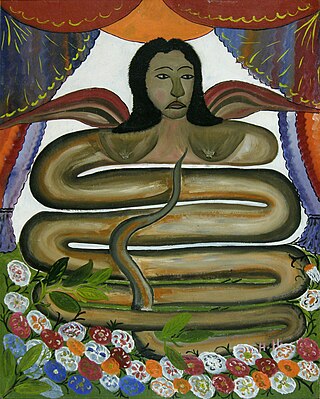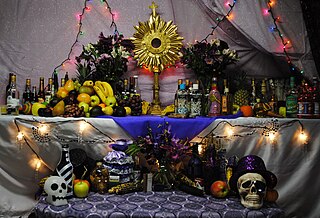
Lwa, also called loa, are spirits in the African diasporic religion of Haitian Vodou. They have also been incorporated into some revivalist forms of Louisiana Voodoo. Many of the lwa derive their identities in part from deities venerated in the traditional religions of West Africa, especially those of the Fon and Yoruba.
Agwé is a lwa who rules over the sea, fish, and aquatic plants, as well as the patron lwa of fishermen and sailors in Vodou, especially in Haiti. He is believed to live on an underwater island and be married to Erzulie Freda and La Sirene. He goes by several titles, including koki la me, koki dore, "The Angel in the Mirror", "The Eel", and "The Tadpole in the Pond".

Baron Samedi, also written Baron Samdi, Bawon Samedi or Bawon Sanmdi, is one of the lwa of Haitian Vodou. He is a lwa of the dead, along with Baron's numerous other incarnations Baron Cimetière, Baron La Croix and Baron Criminel.
Baron Cimetière is one of the Gede, a spirit of the dead, along with Baron Samedi and Baron La Croix in Vodou. He is said to be the guardian of the cemetery, protecting its graves.
Baron La Croix is one of the Gede, a lwa of the dead and sexuality, along with Baron Samedi and Baron Cimetière in Vodou. He is syncretized with Saint Expeditus. Baron La Croix is also known as Azagon Lacroix.

Papa Legba is a lwa in Haitian Vodou, Dominican Vodou, Winti and Louisiana Voodoo, who serves as the intermediary between God and humanity. He stands at a spiritual crossroads and gives permission to speak with the spirits of Guineé, and is believed to speak all human languages. In Haiti, he is the great elocutioner. Legba facilitates communication, speech, and understanding. He is commonly associated with dogs. Papa Legba is invoked at the beginning of every ceremony. Papa Legba has his origins in the historic West African kingdom of Dahomey, located within present-day Benin.

Maman Brigitte sometimes also written as Manman Brigitte and also known by Gran Brigitte, Grann Brigitte, Manman, Manman Brigit, and Maman Brijit is a death loa and the consort of Baron Samedi in Haitian Vodou. She drinks rum infused with hot peppers and is symbolized by a black rooster. Maman Brigitte protects graves in Haitian cemeteries that are marked by the cross of Baron Samedi. Graves that are protected by Brigitte are marked by a mound of stones. In Vodou practice, the first burials serve as offerings to either Baron Samedi or Maman Brigitte depending on the gender of the person being laid to rest. If the deceased person is male then the grave is dedicated to Baron Samedi; if the deceased person is female then the grave is dedicated to Maman Brigitte.

Erzulie is a family of loa, or spirits, in Vodou.
Haitian mythology consists of many folklore stories from different time periods, involving sacred dance and deities, all the way to Vodou. Haitian Vodou is a syncretic mixture of Roman Catholic rituals developed during the French colonial period, based on traditional African beliefs, with roots in Dahomey, Kongo and Yoruba traditions, and folkloric influence from the indigenous Taino peoples of Haiti. The lwa, or spirits with whom Vodou adherents work and practice, are not gods but servants of the Supreme Creator Bondye. A lot of the Iwa identities come from deities formed in the West African traditional regions, especially the Fon and Yoruba. In keeping with the French-Catholic influence of the faith, Vodou practioneers are for the most part monotheists, believing that the lwa are great and powerful forces in the world with whom humans interact and vice versa, resulting in a symbiotic relationship intended to bring both humans and the lwa back to Bondye. "Vodou is a religious practice, a faith that points toward an intimate knowledge of God, and offers its practitioners a means to come into communion with the Divine, through an ever evolving paradigm of dance, song and prayers."

A veve is a religious symbol commonly used in different branches of Vodun throughout the African diaspora, such as Haitian Vodou and Louisiana Voodoo. The veve acts as a "beacon" for the lwa, and will serve as a lwa's representation during rituals.

Homosexuality in Haitian Vodou is religiously acceptable and homosexuals are allowed to participate in all religious activities. However, in West African countries with major conservative Christian and Islamic views on LGBTQ people, the attitudes towards them may be less tolerant if not openly hostile and these influences are reflected in African diaspora religions following Atlantic slave trade which includes Haitian Vodou.

Haitian Vodou is an African diasporic religion that developed in Haiti between the 16th and 19th centuries. It arose through a process of syncretism between several traditional religions of West and Central Africa and Roman Catholicism. There is no central authority in control of the religion and much diversity exists among practitioners, who are known as Vodouists, Vodouisants, or Serviteurs.
Gede Nibo is a lwa who is leader of the spirits of the dead in Haitian Vodou. Formerly human, Gede Nibo was a handsome young man who was killed violently. After death, he was adopted as a lwa by Baron Samedi and Maman Brigitte. He is envisioned as an effeminate, nasal dandy. Nibo wears a black riding coat or drag. When he inhabits humans they are inspired to lascivious sexuality of all kinds.
Baron Criminel is a powerful spirit or loa in the Haitian Vodou religion. He is envisioned as the first murderer who has been condemned to death, and is invoked to pronounce swift judgment. Baron Criminel is syncretized with Saint Martin de Porres, perhaps because his feast day is November 3, the day after Fête Guede or Fête Ghede. His colors are black, purple, white and deep blood red.

LGBT themes in mythology occur in mythologies and religious narratives that include stories of romantic affection or sexuality between figures of the same sex or that feature divine actions that result in changes in gender. These myths are considered by some modern queer scholars to be forms of lesbian, gay, bisexual, or transgender (LGBT) expression, and modern conceptions of sexuality and gender have been retroactively applied to them. Many mythologies ascribe homosexuality and gender fluidity in humans to the action of gods or of other supernatural interventions.
Various LGBT themes are present in different in African diasporic mythologies, primary among them being Voodoo.

Dominican Vudú, or Dominican Voodoo, popularly known as Las 21 Divisiones, is a heavily Catholicized syncretic religion of African-Caribbean origin which developed in the erstwhile Spanish colony of Santo Domingo on the island of Hispaniola.

Haitian Vodou art is art related to the Haitian Vodou religion. This religion has its roots in West African traditional religions brought to Haiti by slaves, but has assimilated elements from Europe and the Americas and continues to evolve. The most distinctive Vodou art form is the drapo Vodou, an embroidered flag often decorated with sequins or beads, but the term covers a wide range of visual art forms including paintings, embroidered clothing, clay or wooden figures, musical instruments and assemblages. Since the 1950s there has been growing demand for Vodou art by tourists and collectors.

"The Guardian" is the eighteenth episode of the seventh season and the 151st episode overall of the American fantasy-drama series Once Upon a Time. Written by David H. Goodman & Brigitte Hales, and directed by Geofrey Hildrew, it premiered on ABC in the United States on April 20, 2018.










